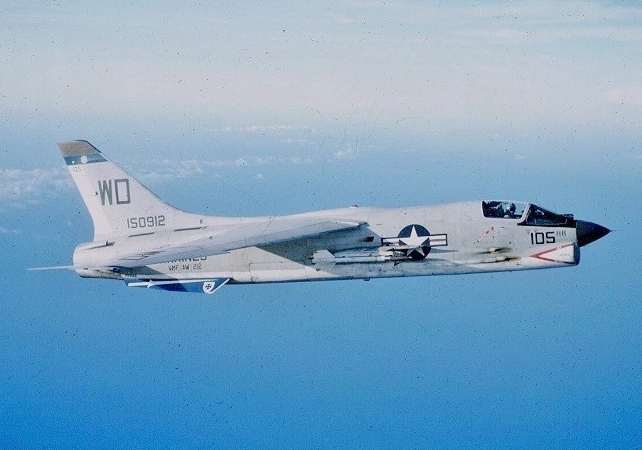Winston
Lorenzo von Matterhorn
- Joined
- Jan 31, 2009
- Messages
- 9,560
- Reaction score
- 1,748
Rider on the Storm
The story of an unplanned and prolonged skydive through a thunderstorm
https://www.damninteresting.com/rider-on-the-storm/
Excerpt:
In the summer of 1959, a pair of F-8 Crusader combat jets were on a routine flight to Beaufort, North Carolina with no particular designs on making history. The late afternoon sunlight glinted from the silver and orange fuselages as the US Marine Corps pilots flew high above the Carolina coast at near the speed of sound. The lead jet was piloted by 39-year-old Lt Col William Rankin, a veteran of both World War 2 and the Korean War. In another Crusader followed his wingman, Lt Herbert Nolan. The pilots were cruising at 47,000 feet to stay above a large, surly-looking column of cumulonimbus cloud which was amassing about a half mile below them, threatening to moisten the officers upon their arrival at the air field.
Mere minutes before they were scheduled to begin their descent towards Beaufort, William Rankin heard a decreasingly reassuring series of grinding sounds coming from his aircrafts engine. The airframe shuddered, and most of the indicator needles on his array of cockpit instruments flopped into their fluorescent orange something is horribly wrong regions. The engine had stopped cold. As the unpowered aircraft dipped earthward, Lt Col Rankin switched on his Crusaders emergency generator to electrify his radio. Power failure, Rankin transmitted matter-of-factly to Nolan. May have to eject.
Unable to restart his engine, and struggling to keep his craft from entering a near-supersonic nose dive, Rankin grasped the two emergency eject handles. He was mindful of his extreme altitude, and of the serious discomfort that would accompany the sudden decompression of an ejection; but although he lacked a pressure suit, he knew that his oxygen mask should keep him breathing in the rarefied atmosphere nine miles up. He was also wary of the ominous gray soup of a storm that lurked below; but having previously experienced a bail out amidst enemy fire in Korea, a bit of inclement weather didnt seem all that off-putting. At approximately 6:00pm, Lt Col Rankin concluded that his aircraft was unrecoverable and pulled hard on his eject handles. An explosive charge propelled him from the cockpit into the atmosphere with sufficient force to rip his left glove from his hand, scattering his canopy, pilot seat, and other plane-related debris into the sky. Bill Rankin had spent a fair amount of time skydiving in his careerboth premeditated and otherwisebut this particular dive would be unlike any that he or any living person had experienced before.

The story of an unplanned and prolonged skydive through a thunderstorm
https://www.damninteresting.com/rider-on-the-storm/
Excerpt:
In the summer of 1959, a pair of F-8 Crusader combat jets were on a routine flight to Beaufort, North Carolina with no particular designs on making history. The late afternoon sunlight glinted from the silver and orange fuselages as the US Marine Corps pilots flew high above the Carolina coast at near the speed of sound. The lead jet was piloted by 39-year-old Lt Col William Rankin, a veteran of both World War 2 and the Korean War. In another Crusader followed his wingman, Lt Herbert Nolan. The pilots were cruising at 47,000 feet to stay above a large, surly-looking column of cumulonimbus cloud which was amassing about a half mile below them, threatening to moisten the officers upon their arrival at the air field.
Mere minutes before they were scheduled to begin their descent towards Beaufort, William Rankin heard a decreasingly reassuring series of grinding sounds coming from his aircrafts engine. The airframe shuddered, and most of the indicator needles on his array of cockpit instruments flopped into their fluorescent orange something is horribly wrong regions. The engine had stopped cold. As the unpowered aircraft dipped earthward, Lt Col Rankin switched on his Crusaders emergency generator to electrify his radio. Power failure, Rankin transmitted matter-of-factly to Nolan. May have to eject.
Unable to restart his engine, and struggling to keep his craft from entering a near-supersonic nose dive, Rankin grasped the two emergency eject handles. He was mindful of his extreme altitude, and of the serious discomfort that would accompany the sudden decompression of an ejection; but although he lacked a pressure suit, he knew that his oxygen mask should keep him breathing in the rarefied atmosphere nine miles up. He was also wary of the ominous gray soup of a storm that lurked below; but having previously experienced a bail out amidst enemy fire in Korea, a bit of inclement weather didnt seem all that off-putting. At approximately 6:00pm, Lt Col Rankin concluded that his aircraft was unrecoverable and pulled hard on his eject handles. An explosive charge propelled him from the cockpit into the atmosphere with sufficient force to rip his left glove from his hand, scattering his canopy, pilot seat, and other plane-related debris into the sky. Bill Rankin had spent a fair amount of time skydiving in his careerboth premeditated and otherwisebut this particular dive would be unlike any that he or any living person had experienced before.





